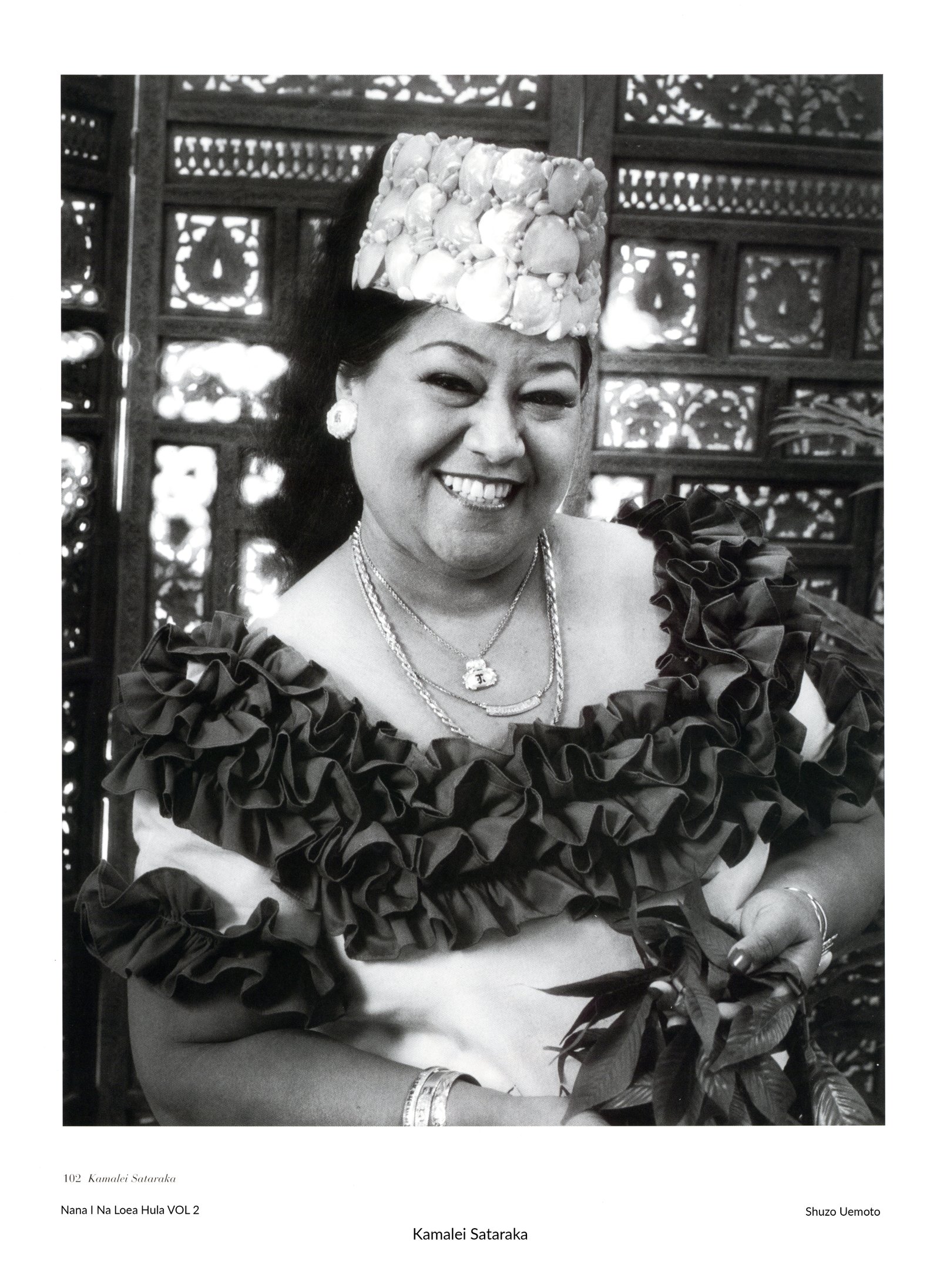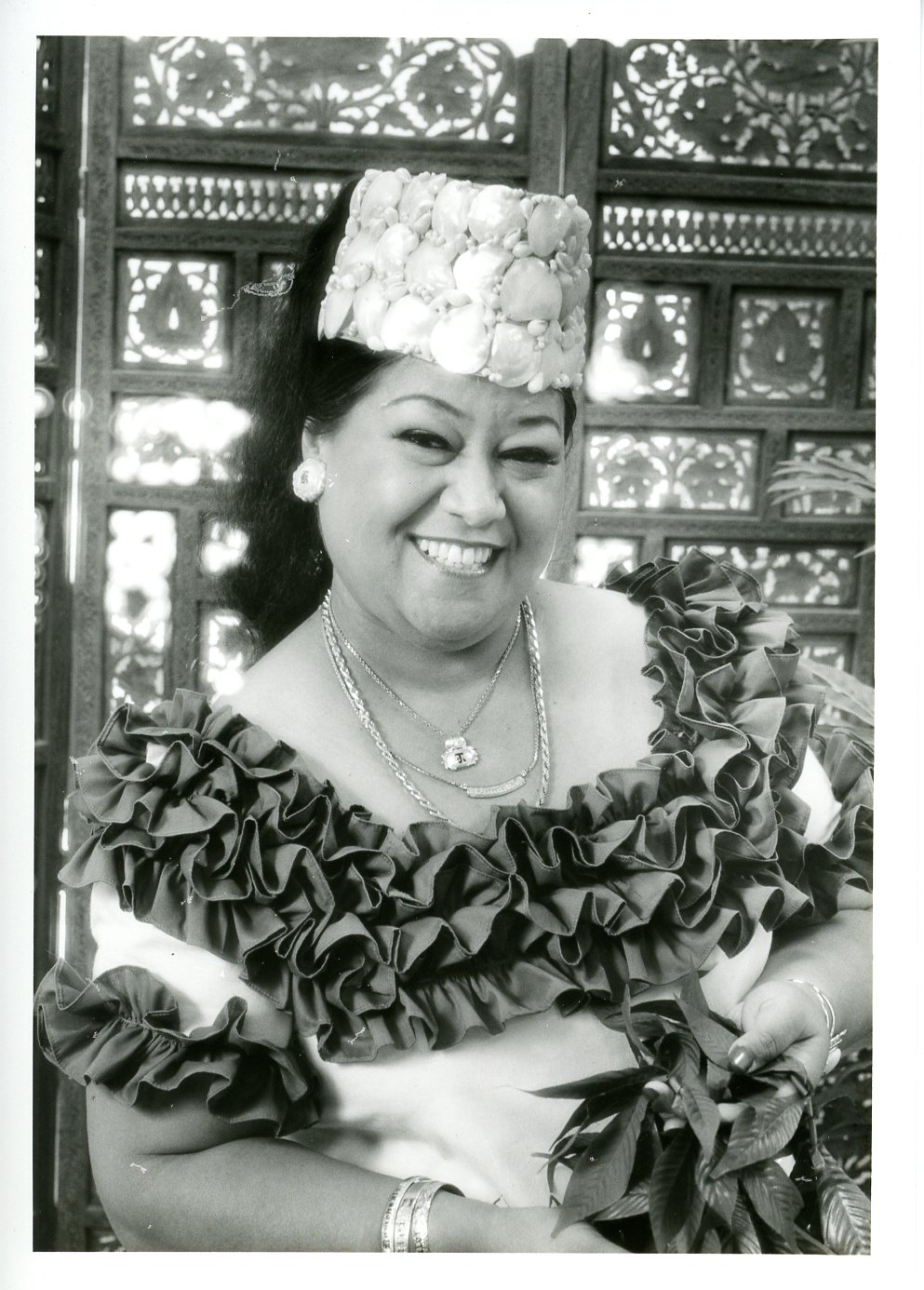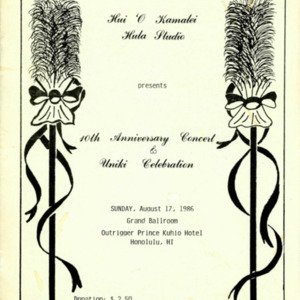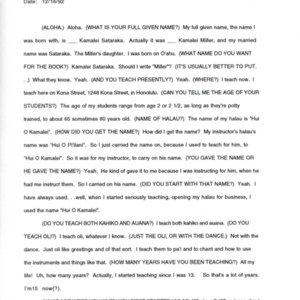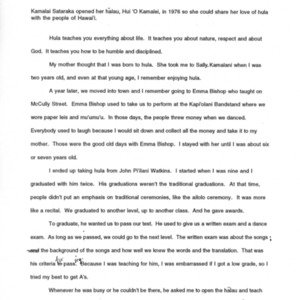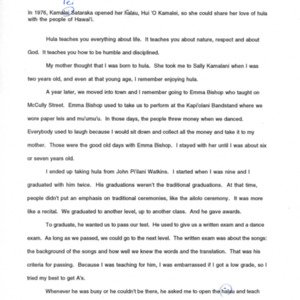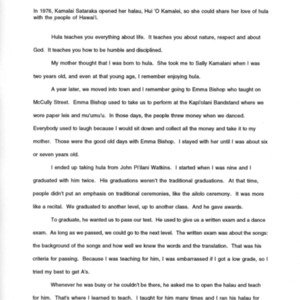Kamalei Sataraka
Title
Kamalei Sataraka
Subject
Nā Kumu Hula Kamalei Sataraka - Nānā I Nā Loea Hula Volume 2 Page 103
Description
In 1976 Kamalei Sataraka opened her hālau Hui ‘O Kamalei so she could share her love of hula with the people of Hawaiʻi.
Hula teaches you everything about life. It teaches you about nature, respect, and about God. It teaches you how to be humble and disciplined.
My mother thought that I was born to hula. She took me to Sally Kamalani when I was two-years-old and even at that young age I remember enjoying hula.
A year later we moved into town and I remember going to Emma Bishop who taught on McCully Street. Emma Bishop used to take us to perform at the Kapi'olani Bandstand where we wore paper leis and mu’umu’u. In those days the people threw money when we danced. Everybody used to laugh because I would sit down and collect all the money and take it to my mother. Those were the good old days with Emma Bishop. I stayed with her until I was about six or seven-years-old.
I ended up taking hula from John Pi'ilani Watkins. I started when I was nine and I graduated with him twice. His graduations weren’t the traditional graduations. At that time people didn’t put an emphasis on traditional ceremonies like the ‘ailolo ceremony. It was more like a recital. We graduated to another level and he gave awards.
To graduate he wanted us to pass a test. He used to give us a written exam and a dance exam. As long as we passed, we could go to the next level. The written exam was about the songs: the background of the songs and how well we knew the words and the translation. That was his criteria for passing. Because I was teaching for him, I was embarrassed if I got a low grade so I tried my best to get As.
Whenever he was busy or he couldn’t be there, he asked me to open the hālau and teach for him. That’s where I learned to teach. I taught for him many times and I ran his hālau for him while I was in high school.
I attribute most of my hula training to John Pi'ilani Watkins. He was really before his time. What I got from him was basically show business and not much tradition. He took us to New York where we worked under June Taylor, the choreographer for the Jackie Gleason Show and the Dean Martin Show. I really enjoyed dancing with John Pi‘ilani Watkins because I’m pretty much an entertainer myself.
When I was eighteen-years- old, I left Johnny Watkins and a couple of us formed our own group. We started traveling all over the world. We went to Japan many times and to Korea. We tried to travel as much as we could while we were young.
I started yearning for the traditional part of hula that I did not get from Johnny Watkins. When I came back from traveling, I did research on my own. I taught myself most of it. I took anything that I could learn from anybody and I was very curious and inquisitive. I think that a lot of where I am today can be attributed to my own desire to make myself a better kumu hula.
What I wanted to do was to open a hula studio that would teach people the simple fact that hula can open gates for anyone. They can travel around the world and they can do anything they want to do as long as they put their mind to it. Nothing is unattainable. My goal was to take my students around the world as entertainers and part of that goal is fulfilled.
The greatest accomplishment for me is entering competitions. When I opened the hālau, I thought competitions were out of my league. But the students asked to enter so we tried. Whether you win or lose, simply participating is an accomplishment in itself.
I ‘ūniki my students but not traditionally. They have to go to language classes; they have to be able to make their palm drum and their ipu heke; they have to be able to oli, to dance kahiko and ʻauana, and dance with the implements.
The advice I would give the young hula teachers of today is to instill in their haumāna, love and confidence. You have to tell your children to be inquisitive and to do their research if they want to carry on the traditions of hula. I don t consider myself a traditional hula teacher but I do consider myself a good hula teacher.
I think hula has gotten more lively and more progressive. There are the purists who want it to stay the same but I really don’t think hula will stay the same. Like everything else Hawaiʻi is progressing; things will keep moving and we do move with the flow. It would be nice if we can keep our traditions the way they were in the past but I really don’t want to go back to the past. Hula is progressing but it will get, to a point where it will come full circle. Like the clothes that we wore in the Forties, they’ll come around again.
Lastly I feel all patrons of the hula need to focus on the Man above, the Creator of all who allows us to do what we do. We also teach our haumāna and ‘ohana to understand and respect the gods of yesterday for our ancestors felt that their ancestors were embodied in spirit, in everything they owned. Today we still carry that respect but the majority of us are Christians in various denominations. Therefore we follow the teachings of Jesus Christ. Focus on him, our Lord through Jesus, and he will not give us anything we cannot handle!
Nānā I Nā Loea Hula 103
Hula teaches you everything about life. It teaches you about nature, respect, and about God. It teaches you how to be humble and disciplined.
My mother thought that I was born to hula. She took me to Sally Kamalani when I was two-years-old and even at that young age I remember enjoying hula.
A year later we moved into town and I remember going to Emma Bishop who taught on McCully Street. Emma Bishop used to take us to perform at the Kapi'olani Bandstand where we wore paper leis and mu’umu’u. In those days the people threw money when we danced. Everybody used to laugh because I would sit down and collect all the money and take it to my mother. Those were the good old days with Emma Bishop. I stayed with her until I was about six or seven-years-old.
I ended up taking hula from John Pi'ilani Watkins. I started when I was nine and I graduated with him twice. His graduations weren’t the traditional graduations. At that time people didn’t put an emphasis on traditional ceremonies like the ‘ailolo ceremony. It was more like a recital. We graduated to another level and he gave awards.
To graduate he wanted us to pass a test. He used to give us a written exam and a dance exam. As long as we passed, we could go to the next level. The written exam was about the songs: the background of the songs and how well we knew the words and the translation. That was his criteria for passing. Because I was teaching for him, I was embarrassed if I got a low grade so I tried my best to get As.
Whenever he was busy or he couldn’t be there, he asked me to open the hālau and teach for him. That’s where I learned to teach. I taught for him many times and I ran his hālau for him while I was in high school.
I attribute most of my hula training to John Pi'ilani Watkins. He was really before his time. What I got from him was basically show business and not much tradition. He took us to New York where we worked under June Taylor, the choreographer for the Jackie Gleason Show and the Dean Martin Show. I really enjoyed dancing with John Pi‘ilani Watkins because I’m pretty much an entertainer myself.
When I was eighteen-years- old, I left Johnny Watkins and a couple of us formed our own group. We started traveling all over the world. We went to Japan many times and to Korea. We tried to travel as much as we could while we were young.
I started yearning for the traditional part of hula that I did not get from Johnny Watkins. When I came back from traveling, I did research on my own. I taught myself most of it. I took anything that I could learn from anybody and I was very curious and inquisitive. I think that a lot of where I am today can be attributed to my own desire to make myself a better kumu hula.
What I wanted to do was to open a hula studio that would teach people the simple fact that hula can open gates for anyone. They can travel around the world and they can do anything they want to do as long as they put their mind to it. Nothing is unattainable. My goal was to take my students around the world as entertainers and part of that goal is fulfilled.
The greatest accomplishment for me is entering competitions. When I opened the hālau, I thought competitions were out of my league. But the students asked to enter so we tried. Whether you win or lose, simply participating is an accomplishment in itself.
I ‘ūniki my students but not traditionally. They have to go to language classes; they have to be able to make their palm drum and their ipu heke; they have to be able to oli, to dance kahiko and ʻauana, and dance with the implements.
The advice I would give the young hula teachers of today is to instill in their haumāna, love and confidence. You have to tell your children to be inquisitive and to do their research if they want to carry on the traditions of hula. I don t consider myself a traditional hula teacher but I do consider myself a good hula teacher.
I think hula has gotten more lively and more progressive. There are the purists who want it to stay the same but I really don’t think hula will stay the same. Like everything else Hawaiʻi is progressing; things will keep moving and we do move with the flow. It would be nice if we can keep our traditions the way they were in the past but I really don’t want to go back to the past. Hula is progressing but it will get, to a point where it will come full circle. Like the clothes that we wore in the Forties, they’ll come around again.
Lastly I feel all patrons of the hula need to focus on the Man above, the Creator of all who allows us to do what we do. We also teach our haumāna and ‘ohana to understand and respect the gods of yesterday for our ancestors felt that their ancestors were embodied in spirit, in everything they owned. Today we still carry that respect but the majority of us are Christians in various denominations. Therefore we follow the teachings of Jesus Christ. Focus on him, our Lord through Jesus, and he will not give us anything we cannot handle!
Nānā I Nā Loea Hula 103
Citation
“Kamalei Sataraka,” Nā Kumu Hula Archive, accessed October 15, 2025, https://nakumuhula.org/archive/items/show/149.
